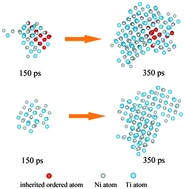The atomic-scale nucleation mechanism of NiTi metallic glasses upon isothermal annealing studied via molecular dynamics simulations†
Abstract
Nucleation is one of the most essential transformation paths in phase transition and exerts a significant influence on the crystallization process. Molecular dynamics simulations were performed to investigate the atomic-scale nucleation mechanisms of NiTi metallic glasses upon devitrification at various temperatures (700 K, 750 K, 800 K, and 850 K). Our simulations reveal that at 700 K and 750 K, nucleation is polynuclear with high nucleation density, while at 800 K it is mononuclear. The underlying nucleation mechanisms have been clarified, manifesting that nucleation can be induced either by the initial ordered clusters (IOCs) or by the other precursors of nuclei evolved directly from the supercooled liquid. IOCs and other precursors stem from the thermal fluctuations of bond orientational order in supercooled liquids during the quenching process and during the annealing process, respectively. The simulation results not only elucidate the underlying nucleation mechanisms varied with temperature, but also unveil the origin of nucleation. These discoveries offer new insights into the devitrification mechanism of metallic glasses.


 Please wait while we load your content...
Please wait while we load your content...